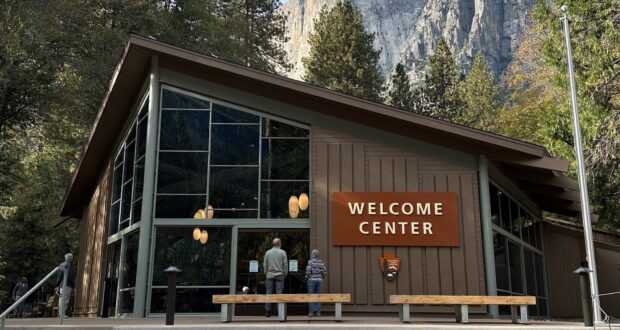YOSEMITE NATIONAL PARK – What can visitors expect in Yosemite National Park for 2024? There are notable improvements to some of the park’s most visited spots headlined by the renovated approach to iconic Bridalveil Fall, now open to visitors and offering a front-row view of the 620-foot roaring waterfall that millions see each year entering Yosemite Valley. The new Yosemite Valley Welcome Center is a one-stop shop to plan outings that’s easier to access. Also, a renovated Yosemite Exploration Center (formerly the Yosemite Valley Visitor Center) has new science and history exhibits.
“This year, park visitors will experience restored access to park landmarks and enhanced visitor facilities that spotlight cultural history, protect natural resources, and add enjoyment to any visit,” said Yosemite National Park Superintendent Cicely Muldoon. “A prime example is a dramatically improved experience at Bridalveil Fall after a multi-year renovation.”
Projects like Bridalveil Fall are possible by donations to the nonprofit Yosemite Conservancy. Just today the Conservancy announced $18 million more in support to the park. In 2024, the Conservancy will fund 60 new projects to restore trails and ecosystems. The projects will also advance scientific and historical research, protect wildlife and facilitate positive visitor experiences.
“The famous view of Bridalveil Fall and Yosemite Valley from Tunnel View is astounding, but until now the experience of visiting the fall up close has been less than ideal,” said Yosemite Conservancy President Frank Dean. “The old, often crowded viewing platform was expanded nearly fourfold, providing visitors with options to pause, rest, and take in the stunning beauty of the fall plummeting from the Valley rim above. Improvements like this happen with the support of people who love Yosemite.”
Bridalveil Fall Viewing Area
 The base at Bridalveil Fall has new viewing area. These areas provide safer, less crowded and defined locations to enjoy the majesty of the fall and protect habitat. A reconfigured parking lot eases congestion. There are modern flush toilets instead of vault toilets, wayfinding and wider hiking trails. Many of these trails have elevated wooden boardwalks and seasonal stream channels to protect wetlands and riparian habitat. An ADA-compliant loop trail and viewing platform offer improved access. New interpretive exhibits are scheduled for installation this summer. After heavy snowfall this past winter, Bridalveil Fall and many other Yosemite waterfalls and ephemeral falls will be more spectacular than ever.
The base at Bridalveil Fall has new viewing area. These areas provide safer, less crowded and defined locations to enjoy the majesty of the fall and protect habitat. A reconfigured parking lot eases congestion. There are modern flush toilets instead of vault toilets, wayfinding and wider hiking trails. Many of these trails have elevated wooden boardwalks and seasonal stream channels to protect wetlands and riparian habitat. An ADA-compliant loop trail and viewing platform offer improved access. New interpretive exhibits are scheduled for installation this summer. After heavy snowfall this past winter, Bridalveil Fall and many other Yosemite waterfalls and ephemeral falls will be more spectacular than ever.
Welcome Center
Dean said the new Yosemite Valley Welcome Center that opened in winter is “a great gathering place where visitors can plan itineraries or regroup after a day in the park.” The new complex is now a short stroll from the adjacent central parking lot. This makes it easy to find and access. National Park Service Rangers and volunteers provide information at the 3,000-square-foot building. That building was once occupied by a retail store in Yosemite Village. It also has trip planning resources and is home to a Yosemite Conservancy bookstore. Outside, an expansive plaza offers seating, informational signs and maps. There are also new restrooms.
Yosemite Exploration Center
Conservancy staff now host the renovations at the Yosemite Exploration Center which anchors the Yosemite Village area. This area also houses the Yosemite Museum and the Yosemite Theater. A new science and history exhibit, “Yosemite Now,” tells conservation stories of towering trees. Also, about the courageous creatures, wild waters and magnificent meadows, and the people of Yosemite through the ages.
Visitors are able to examine a device scientists use to test water and determine what creature’s DNA is present. They can get a close-up look at the bones in a bear’s paw. They can even rotate wheels that show seasonal meadow, tree, creature and waterflow patterns. Another exhibit uses a special visual treatment called a lenticular that allows visitors to literally look to the past to understand the present by shifting their gaze.
“This is the first time we have worked with the National Park Service to design a space that is meant to educate and engage, as well as showcase Conservancy merchandise, which helps raise money to continue funding park projects,” said Yosemite Conservancy Chief of Yosemite Operations Adonia Ripple. “We’re excited to greet visitors.”
Additional Yosemite Conservancy support this year spans projects, programs and services. They help repair trails, restore wetlands and wilderness, study and protect wildlife. There are efforts make Yosemite’s outreach more inclusive, inspire the next generation of park champions and more. Among them are continuing the restoration of Ackerson Meadow, the largest wetland restoration project in Yosemite’s history. Research and stream restoration continues in order to find ways to protect Giant Sequoias. Another study will seek ways to improve visitor access getting in and out of the park gates efficiently. This will be a direct visitor improvement.
Mist Trail
 There are also grants to upgrade the Mist Trail, one of the most popular trails in the entire National Parks system. The trail that winds along the Merced River and up steep, wet paths to the spray zone of Vernal Fall. Research will continue to protect imperiled Pacific fishers, Sierra Nevada red fox and great gray owls. Still other grants will support the park’s Junior Ranger programming and the popular “Ask a Climber” program. The grant swill also aid in documenting Chinese-American history in the park.
There are also grants to upgrade the Mist Trail, one of the most popular trails in the entire National Parks system. The trail that winds along the Merced River and up steep, wet paths to the spray zone of Vernal Fall. Research will continue to protect imperiled Pacific fishers, Sierra Nevada red fox and great gray owls. Still other grants will support the park’s Junior Ranger programming and the popular “Ask a Climber” program. The grant swill also aid in documenting Chinese-American history in the park.
About Yosemite Conservancy
The Conservancy’s contributions now top out at more than $200 million in the past decade alone. This includes more than 850 Conservancy-funded projects completed. Notable past projects include the restoration and protection of the Mariposa Grove of Giant Sequoias, renovated overlooks such as Tunnel View, Olmsted Point, Lower Yosemite Fall, and Glacier Point, restored meadows in Yosemite Valley and the high country, and protecting peregrine falcons, red-legged frogs and Sierra Nevada bighorn sheep.
The Conservancy also supports the park through a variety of visitor programs and retail operations, including by offering naturalist-led outdoor adventures, art classes, donor events and volunteer programs; operating physical bookstores in the park and an online store; and managing the online wilderness permit reservation process. The Conservancy’s four webcams, which show El Capitan, Half Dome, the High Sierra, and Yosemite Falls help people connect with the park from afar.
For more than 100 years, Yosemite Conservancy has been supporting the conservation of Yosemite’s natural resources and helping people develop deep ties to the park. Thanks to generous donors, in recent years, we have provided more than $162 million in grants to Yosemite for more than 850 projects, and more than $200 million in overall support in the past decade alone, including securing matching funds for major projects and in-kind donations of staffing, services, and park-based programming. In 2024, we are providing $18 million in total support and funding around 60 new grants to the National Park Service for projects in the park.
The Conservancy’s guided adventures and art classes, donor events, volunteer opportunities, wilderness services, and bookstores help people from across the country and world connect with Yosemite. Learn more at yosemite.org.






